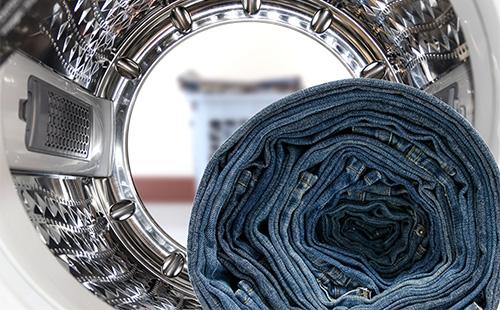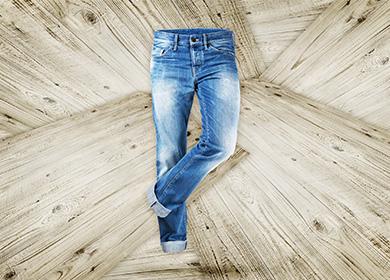The content of the article
A few centuries ago, dyeing fabrics was a venerable craft. Not everyone could afford to use the services of dyers. Today, such services are provided in dry cleaning and some ateliers. But why overpay if the hostess is available a wide range of traditional and alternative means.
Choosing a store drug
Is it possible to color jeans or jeans clothes blue? Of course, you can repaint, because this does not require any special skills. The main thing is to determine the color and type of dye.
If you do not know what paint to paint jeans, go to a specialized store. Depending on the desired effect, you can choose the right tool.
Table - Advantages and disadvantages of different types of dyes
| Dye type | Advantages | disadvantages | Appointment |
|---|---|---|---|
| Blue | - Affordable price; - ease of use; - security | - Low durability (blue color is washed out after two washings) | - To give freshness to blue or blue color |
| Aniline paint | - Ease of use; - the ability to mix colors among themselves | - Low resistance; - burns out in the sun | - To create color streaks and other original effects |
| Acrylic paint | - color fastness; - a wide palette of shades; - ease of use | - High price | - For art painting of fabric |
| Powder dye | - Low price; - ease of use | - Low resistance; - a small selection of shades | - For painting faded jeans |
Features of the use of acrylic products
What is the color of jeans if you want to get an original thing at the exit, no one else will have analogues? The ideal option is bright and resistant acrylic paints that will not fade or fade. They are used for art painting - a good option to refresh a thing or hide a stain. The use of this type of paint has seven features.
- Training. Before starting work, the jeans are washed and completely dried and ironed. This will allow the paint to better fix between the fibers.
- Ease of application. The area on which the drawing will be applied must be put on a flat surface and fixed (for example, with paper clips or double-sided tape).
- Outline the outline. This can be done with a soft pencil or carbon paper.
- Paint amount. The acrylic layer should be as thin as possible. Otherwise, it may begin to climb.
- Right brush. To apply a clear pattern, which implies a dense overlap, soft bristles are suitable. For translucent patterns, it is better to use hard brushes.
- Drying. Acrylic cures instantly. But for it to completely dry, it will take at least 15 hours.
- Result capture. To keep the paint firmly on the jeans, iron the product from the wrong side or through a sheet of paper.
How to dye jeans with powder dye: 2 ways
Powder dyes are the most common. They are easy to use and very inexpensive. There are two ways to use this kind of tool.
In the washing machine
Painting jeans in the washing machine is the best option for those who value their time. The procedure is carried out in six stages.
- Jeans preparation. Wash, rinse and dry your jeans well. If stains or particles of detergent remain on the fabric, the dye will not be evenly distributed.
- Preparation of dye. According to the instructions, prepare a coloring composition. If using a powder, stir thoroughly so that there are no lumps. Otherwise, the fabric will stain unevenly. You may need to strain the composition through several layers of gauze.
- Loading. Load the jeans into the drum, and pour in the prepared coloring compound there. Immediately proceed to the next step so that the pigment does not have time to eat into the tissue.
- Mode selection. Jeans must spend at least two hours in the washing machine, and therefore you should choose the longest washing mode. The water temperature should be as high as possible, according to the label.
- Fixation of the result. When the staining process is complete, put the jeans in a basin of acidified water for a quarter of an hour. For every liter of liquid, two tablespoons of vinegar should be present.
- Final wash. To remove dye residues from the fabric and eliminate the smell of vinegar, wash the jeans in the machine again without any detergents. This time, the water temperature should not exceed 40 ° C.
In an enameled basin
If you want to control the staining process, you will have to do everything manually. For these purposes, an enameled pelvis is ideal. Follow the instructions in seven steps.
- Cooking paint. According to the instructions, dilute the dye in water. If there are undissolved lumps, the mixture must be filtered through cheesecloth.
- Preparing a container of water. Pour about 7 liters of water into a large enameled basin. Place a container of water on a fire.
- Product immersion. When the water warms up well, dissolve the dye in it and immerse the jeans. The liquid should be hot enough, but not boiling.
- Cooking. For 40-60 minutes, boil the jeans in a coloring composition.
- Rinsing. After cooking, rinse the product first in hot and then in cold water.
- Pin color. Dip the jeans in a vinegar solution (two tablespoons per liter of water) for a quarter of an hour.
- Final wash. Wash jeans in warm water with a little powder or laundry soap.
Alternative solutions
If you like experiments, buying a dye and then using it according to the instructions is too commonplace and boring. A number of alternative remedies will help achieve the desired color and original effects.
Chlorine Bleach
Features Varenki is the legendary jeans. More than one generation of mods has sought to possess this thing. The technique came to us from Japan. There, nodular staining is elevated to the rank of art. If you want to show off in jeans with beautiful white stains, you have to conjure a little thing.
Treatment
- Fill a metal bucket with water and add a glass of chlorine bleach.
- Crumple the jeans into a lump or twist and tightly tie with a rope to fix the shape.
- Immerse the item in liquid and place the bucket on the burner.
- Boil jeans over medium heat for a quarter hour.
- Rinse the product thoroughly in cold water.
Potassium permanganate
Features Potassium permanganate is another means by which you can make fashionable "varenki". This is a great way to partially dye jeans by hand without boiling or any other heat treatment.
Treatment
- Mix a tablespoon with a slide of manganese with half a glass of vinegar and two tablespoons of peroxide.
- Dilute the resulting composition with water (3 L).
- Twist the jeans tightly and secure them with ropes or elastic bands.
- Place the product in the solution for 20 minutes.
- Rinse the jeans several times in cold water and wash them with powder.
Zelenka
Features If you want to color the jeans green, the perfect tool is green. Through simple manipulations, you can turn it into an excellent dye for clothes.
Treatment
- If you want to dye white jeans, just wash and stroke them. If the product is a different color, it must first be kept in white.
- In 5 l of water dissolve the contents of a standard vial of brilliant green.
- Immerse wet jeans in the solution for half an hour.
- Rinse the product in cold water and soak in water with vinegar for a quarter of an hour.
Hair dye
Features Hair dye is one of the alternative means for dyeing jeans. It gives the fabric a rich shade and holds well. As a rule, it is used in order to color dense regular or velvet jeans.
Treatment
- Pour warm water into a basin or bucket and add paint of the chosen shade. If you use a tonic, then for the brightness of the color you will need two bottles.
- Wash and dried jeans completely immerse in a solution for one and a half to two hours.
- Rinse the product a few times to remove any paint residue. Alternate warm and cold water.
- Pour water into the container. For each liter, add two tablespoons of vinegar and one tablespoon of salt. Soak item for 15 minutes.
- Wash the product in powder and hang to dry away from sunlight and heating appliances.

Vegetables, berries, herbs
Features You can color light jeans at home with food. Natural dyes of all colors of the rainbow from the table will help you in experiments with style. The process includes four stages.
Treatment
- Squeeze juice from berries or vegetables and dilute it with hot water. Pour dry herbs or spices with boiling water and let it brew until it cools. The proportions of the dye and water are determined "by eye". The more pigment, the brighter the color.
- Place the product in the solution container. The fluid should completely cover it.
- Turn the item over for three to five hours to distribute the dye evenly.
- Rinse the product in water, acidified with vinegar or a weak saline solution.
Table - Natural dyes for jeans
| Desired Shade | Natural dye |
|---|---|
| Orange color | - Carrot; - onion peel |
| Yellow | - Bay leaf; - dry flowers of calendula; - turmeric |
| Brown color | - Oak bark; - nutshell; - Black tea |
| Green color | - Sorrel root; - spinach |
| Pink color | - Cherry; - raspberries |
| Grey colour | - blackberry |
| Blue | - Red cabbage |
| Blue colour | - Cauliflower; - dry cornflower petals; - blueberries; - dark grapes |
| Red color | - Garnet; - beets |
Post-Care: Tips
In order to preserve the color of painted things as long as possible, it is important to properly care for them. After reviewing the reviews, there are three key points.
- Water temperature. Painted items should only be washed in cold or slightly warm water. High temperature will help wash out the dye.
- Detergent. Washing powder is best replaced with laundry soap.
- Type of washing. Ideal - hand wash without friction. Use the machine is permissible only in delicate mode.
If you want to reanimate old jeans that have lost color, synthetic and natural dyes will come to your aid. But putting one thing in order, it’s important not to spoil the others. If you decide to dye your jeans with a dye yourself, remember that you need to wash them separately from other clothes. After washing, thoroughly wipe the basin or drum of the washing machine to remove dye particles.

